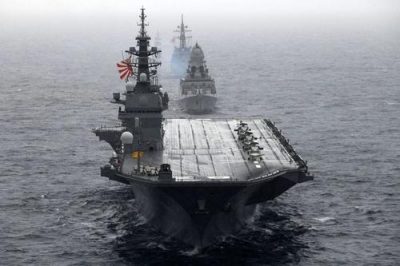US Stealth Jets Become First Fighters to Fly from Japanese Ship Since WWII

All Global Research articles can be read in 51 languages by activating the “Translate Website” drop down menu on the top banner of our home page (Desktop version).
Visit and follow us on Instagram at @crg_globalresearch.
***
In yet another move signaling the deepening US-Japan military relationship, two US stealth fighters practiced taking off and landing on Japan’s largest warship, the JS Izumo. The flights happened Sunday, with Japan’s Ministry of Defense releasing photos and video of the event early this week, hyping the major advance in its Maritime Self-Defense Force’s operations.
Crucially it marked the first time since World War II that fixed-wing aircraft operated from a Japanese warship. Marine Corps Commandant Gen. David Berger was earlier quoted as saying, “We’re not going to go on deployment but we’re actually going to fly U.S. Marine Corps F-35s off of a Japanese ship.”
3 OCT, the #JMSDF conducted verification of takeoff and landing of the USMC F-35B to JS #IZUMO.
The JMSDF continues to steadily carry out the necessary modifications to the IZUMO class to acquire the capability to operate the F-35Bs. pic.twitter.com/0gtPNzrxQC— Japan Maritime Self-Defense Force (@jmsdf_pao_eng) October 5, 2021
Japan’s military is working on adapting 24,000-ton Izumo class helicopter carriers for fixed-wing operations. The pair of US aircraft – Marine Corps F-35B Lighting II Joint Strike Fighters – conducted successful short takeoff, vertical landings from the mid-sized carrier’s deck.
The period of joint Japanese and Marine aircraft trials are set to continue aboard the Izumo through October 7. One aviation analysis monitoring site hailed in its headline that “Japan rejoins aircraft carrier club with USMC F-35B landing.”
Of course, China is sure to take note given also given no less than five total navies currently engaged in warship exercises off Japan, including the US and UK:
Two U.S. carrier strike groups drilled with the United Kingdom’s Carrier Strike Group 21 (CSG21) and a Japanese big-deck warship over the weekend in a major naval exercise in the waters off the southeast of Okinawa, Japan.
The exercise involved six different navies – the U.S Navy, the U.K. Royal Navy, the Japan Maritime Self-Defense Force, the Royal Netherlands Navy, the Royal Canadian Navy and the Royal New Zealand Navy – making up a total of 17 surface ships, which included four aircraft carriers.
The drills come after a tense weekend over contested skies near Taiwan, which saw China PLA jet incursions set multiple records in terms of number of aircraft breaching the self-ruled island’s defense identification zone – including 56 jets on Monday alone.
The Drive, meanwhile, further details Japan’s near-term carrier ambitions and cooperation with the US Marines as follows:
After the concept of fixed-wing operations is proven aboard the Izumo, that warship will then undergo more extensive revisions to better support F-35Bs during routine operations over sustained periods. So far, the vessel has received a heat-resistant flight deck to cope with the F-35B’s scorching exhaust, as well as changes to the lighting and deck markings.
VIDEO: Japan’s Largest Warship Launches U.S. Marine F-35s; First Fighters to Fly from Japanese Ship Since WWII – USNI Newshttps://t.co/zOS6Rc1WeI pic.twitter.com/HHeJ7MIv7W
— U.S. Naval Institute (@NavalInstitute) October 5, 2021
Amid the major joint exercises off Japan, White House spokesperson Jen Psaki said to reporters on Monday, “We urge Beijing to cease its military, diplomatic, and economic pressure and coercion against Taiwan,” and added that the US will “continue to assist Taiwan in maintaining a sufficient self-defense capability.”
Notably, Japan has lately become more vocally and firmly in Washington’s corner of late on the Taiwan issue – also as Japan is engaged in its own small contested island dispute with China off its south – so Beijing is sure to see the latest warship and carrier exercises as aimed in its direction.
*
Note to readers: Please click the share buttons above or below. Follow us on Instagram, @crg_globalresearch. Forward this article to your email lists. Crosspost on your blog site, internet forums. etc.
Featured image: JS Izumo file image via Zero Hedge

